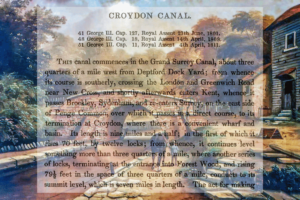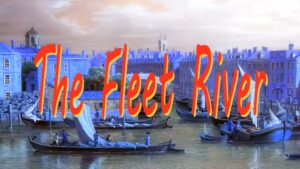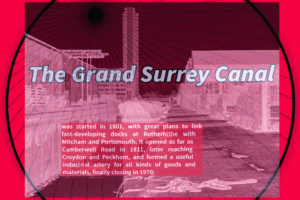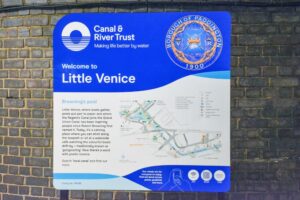Paddington & its transport systems – 3
The Great Western Railway

This was designed by Isambard Kingdom Brunel and it is interesting that his railway opened in the same year his canal bridge was built. It was in 1838 that these events occurred. The railway itself was broad gauge of 7 foot and a quarter inches, and it spread across most of the western parts of England. As history shows standard gauge eventually replaced the entire Brunel designed system. Much information related to the Great Western Railway can be found on the internet. The Paddington terminus itself is still relatively as it was when it opened in the 1850’s, especially the large train sheds which are major listed structures. The train sheds have been restored. There are proposals to build shops between the station and Paddington Basin and there is some concern this might affect the train sheds.
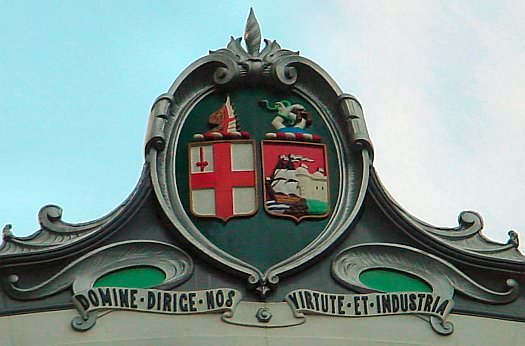
The coat of arms on the Train Shed at Paddington.

Above the train sheds at Paddington the Great Western Railway signs still exist. One may notice that the GWR hotel’s 1931 extension is art deco, though this isn’t mentioned in many guides. The GWR ceased to exist over 60 years ago!
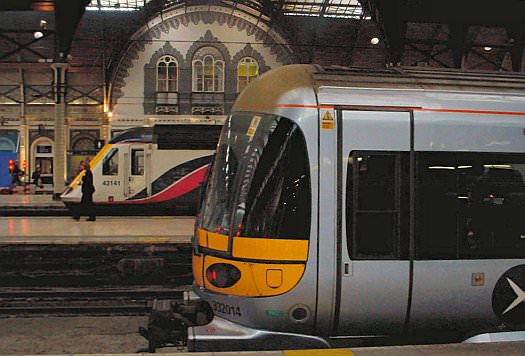
A Heathrow Express’ modern styling compared with a 1970’s HST and 1850’s architecture!
The Metropolitan Railway

The Bayswater, Paddington and Holborn Bridge Railway Company (later North Metropolitan Railway) was set up in 1853 to promote an act for the building of an underground route from Paddington to Holborn Bridge (the actual station was known as Farringdon and High Holborn, situated just to the north of Holborn bridge in the City of London. Funding for the project was difficult to raise but it was eventually secured and construction work began in 1860.
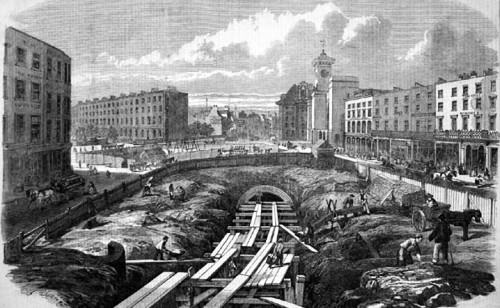
Kings Cross bridge showing the cut and cover method used to construct the Metropolitan Railway. Kings Cross main line station can be seen on the right with its clock tower. This still exists today. Where the completed tunnel begins this is about where the Kings Cross ‘lighthouse’ is sited (this is at the apex of the roads that form Grays Inn and Pentonville Roads.) The site of Kings Cross station would have been just out of sight (behind the artist’s position so to speak.)

Looking along the original 1863 tunnel (now hidden by cladding) at Kings Cross Circle/Hammersmith/Metropolitan station.
Ironically the name Kings Cross Bridge (the street still exists) came about because this was once the head of navigation on the Fleet River. Clearly a definite case of been there done that! Boating was not new to the area and the Regents Canal just happened to be a replacement route for the older one that was lost. Also railways were now making inroads into urban areas thus taking the competition away from the canals. In many ways we can say that the canals definitely felt threatened by so many new rail routes in this corner of the capital. Water was trouble enough for the new railway because it chose to follow some of the Fleet River’s valley and a major disaster occurred in 1862 when the river burst into the rail works.
The now discredited cut and cover system that was used to construct the line meant that chaos ensued on the surface of London’s streets. (Its probably not that much difference from these many road works much of London’s major road routes seem to suffer from!) Trial running on the Metropolitan was begun at the end of 1862, and on Saturday 10th January 1863 the worlds first underground railway service began. The Metropolitan service began from Bishops Road station (the current Hammersmith and City line platforms) which is almost beneath the canal at Paddington basin.

Edgware Road station, this is the 1924 building.
The journey took between 33 and 40 minutes (nowadays its about 20 minutes or more although this is because of changes in the system including staffing change-overs at Edgware Road station and restrictions on train speeds. It used to be an average of 10 minutes journey times until 1990’s. On the very rare occasion it can still be 10 minutes or less in the eastbound direction if the line is completely clear ahead.) It is said that 25,000 passengers used the service on the Metropolitan’s first day in 1863. The service was operated as a broad gauge system in its first years.
Some think that the Metropolitan no longer serves its original 1863 route these days. In some ways it is correct and some ways it is not. The Hammersmith and City line used to be a branch of the Metropolitan system until at least 1990. The Hammersmith and City line serves ALL the stations on the original 1863 route whereas the present Metropolitan Line only serves those stations between Great Portland Street and Farringdon.

Of the first stations on the Metropolitan Railway, only three still retain parts of their original buildings. These are Baker Street, Great Portland Street, Euston Square and Farringdon. At Baker Street’s although the platforms remain the main surface buildings have gone.
The above picture shows the later (early 20th century) works alongside the Marylebone Road which are meant to remind people of the railway’s origins. Two of these windows are marked by red arrows. Despite the impression these windows do not even let light into the original Metropolitan platforms and the windows locations do not correspond with the arches beneath anyway.
Great Portland Street platforms are more or less as they were. Its unusual style of footbridge and surface buildings are a product of rebuilding during the 1930s.
Euston Square is almost a completely new station built in the sixties. The original station buildings were demolished in the early 20th century and their replacement have also been demolished to make way for the Euston underpass. Just part of the original station tunnel remains.
That at Kings Cross still exists in part but is not used by trains. It is sited at Kings Cross Bridge. Two of the platforms were reconstituted in the early 1990’s for the Thameslink services. In 2007 the new station underneath St Pancras was opened and the original Kings Cross platforms, though still extant, no longer sees any use.
The new station, built in the 1940s, is in a location more convenient for the Kings Cross and St Pancras main line rail stations. The original westbound platform and some stairs to street level at Kings Cross Bridge can be seen just before westbound trains enter the tunnels leading to the newer Kings Cross station.
The arched passageway between the platforms at Kings Cross station is actually the old rail tunnel of 1863 and its wide cross-section is a reminder the underground was originally built as a broad gauge railway. Until the 1960s the station had a third platform in the old tunnel section and this was used as a turn back point.
The terminus of the Metropolitan railway was at Farringdon Victoria Street. This was adjacent to Farringdon Road and intended as a temporary terminus until a more substantial one was built on the present site. This second station facilitated the later extensions to Moorgate and Liverpool Street.
These two views of Farringdon and High Holborn Station, the not quite so original terminus of the world’s first underground railway. As these pictures show the buildings are from the 1930s again. The parcels office on the east side must have been unusual for a underground system.
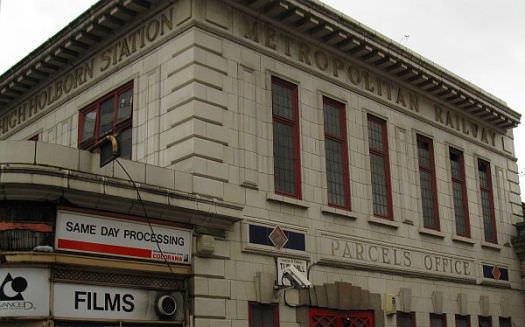
Specially designed steam locomotives were built by Beyer Peacock of Manchester and were fitted with a system for condensing the exhaust steam to reduce the smoke appearing in the tunnels. One of these is preserved at the London Transport Museum, Covent Garden. A westward extension was constructed passing through a new station on the south of Praed Street at Paddington, then to Bayswater, Notting Hill Gate, High Street Kensington and South Kensington. It was opened in 1868, and the open cutting to the east of Paddington station is on part of the site of the former Grand Junction Canal Company’s South Reservoir (see previous page).

Farringdon station in 2009.
Read the Guardian’s article on the 1863 opening of the Metropolitan Railway.
The Post Office Railway

This unmanned, automatic mail delivery rail system ran from Whitechapel to Paddington and was opened in 1927. It served mail sorting offices en route from the Eastern Head District Sorting Office (Whitechapel) Liverpool Street, King Edward Street, Mount Pleasant, New Oxford Street, Rathbone Place, Western Delivery Office (Wimpole Street), Western Parcels office (Bird Street) and Paddington Sorting Office. It served London well for 76 years until 2003. The Royal Mail decided it was too expensive to operate and the last services ran on 31st May 2003.

Post Office Rail station, Mount Pleasant March 1986. Outer tracks were for non-stopping trains.
Paddington & its transport systems – Links and Bibilog
The image of Paddington old church is in the pubic domain and no copyright exists.
Post Office railway map used from The New Zealand Railways Magazine, Volume 4, Issue 5 (September 1, 1929) and downloaded from Wikipedia – the copyright on the image has expired.
Metropolitan railway engraving showing cut and cover works at Kings Cross Bridge used from Wikipedia which informs us the copyright has expired.
Paddington Station old view – Permission is granted to copy, distribute and/or modify this document under the terms of the GNU Free Documentation License.
